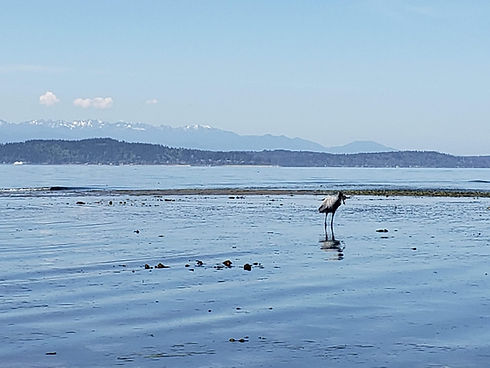
Lincoln Park is a popular, busy park with a large beachfront and trails leading to the clifftops above. There are not a great many features along the beach of Lincoln Park that are typically interesting during low tide, however there is much to be found for the keen observer. There are numerous creatures that I have spotted only at Lincoln Park, so it can certainly provide something a little different.
I prefer to start out at the south end of Lincoln Park a couple hours before the lowest tide of the day and make my way around north. You can either extend your adventure further toward Lowman Beach as the tide continues to recede or head back to see what wasn't visible before. If you do extend your walk further north there are a few interesting places that can be found by a keen observer.
As there are few rocks here that creatures can cling to, most of the interesting stuff at Lincoln Park will be underfoot
Chiton
These small molluscs are easily missed. Look for them on rocky surfaces, often blending in with their surroundings. You may pet them gently with your science finger if you wish. The "mossy" variety feels more rubbery; hairy chiton are softer.

Mossy Chiton

Woody Chiton

Woody Chiton

Mossy Chiton
Anemones
Anemones are abundant at Lincoln park. Aggregating anemones are easiest to find, either underfoot or colonizing rocks. There are large swathes of these that appear in the sand as the tide recedes, often camouflaged with bits of sand or shell. Larger, individual anemones can be found dangling from the underside of rocks.

Painted/ Christmas Anemone

Painted/ Christmas Anemone

Aggregating Anemone

Painted/ Christmas Anemone
Sea Stars
There aren't many sea stars at Lincoln Park as they don't have a ton of great options for safe refuge when the tide recedes. Look for them almost exclusively in rock crevices.

Mottled star

Mottled star

Mottled star
Frilled Dogwelk
This sea snail can be found everywhere on ocean rocks throughout the Pacific Northwest. They vary greatly in shape and color. As you encounter them throughout your tide pool exploring you might believe them to be of different species due to their widely ranging appearance.

Frilled Dog Whelk

Frilled Dog Whelk
Midshipman Fish
I have only observed midshipman fish once, in the tide pools near Lincoln Park. The crows helped me find them due to their interest in nibbling on them! One crow flew away with a smaller specimen. They are found in summer low tides often caring for their eggs. While they may be exposed to predators during low tide, midshipman otherwise fare well as they are able to breathe out of water. These fish have luminous spots on their body, as seen in the photo. Though I wasn't lucky enough to hear it, midshipman fish can "sing" by producing a loud humming sound!

Plainfin Midshipman Fish

Plainfin Midshipman Fish
Moon Snail Collar
Though none were in sight, I have found numerous moon snail egg collars strewn about Lincoln Park's beach. These are easily overlooked as they look like ocean debris, possibly man-made. The female moon snail creates this collar of eggs with mucus secretions and sand, making a shape that forms around the exterior of her body. While the collars are interesting in themselves, they often harbor small organisms such as sea slugs which shelter underneath it. I always try and place them back as I found them to minimize harm.

Egg casing

Egg casing
Thick-Horned Nudibranch
I have had great luck finding these sea slugs hanging out in moon snail egg casings at Lincoln Park. They may often be found among the eel grass. At their largest these guys may only be 3". Be gentle, they don't do well out of the water for long.

Thick-horned Nudibranch

Thick-horned Nudibranch

Thick-horned Nudibranch
Ribbon Worm
Worms of all sorts can be found upon the beach, but rarely do I see them sat upon the beach like this ribbon worm. It resembled a pile of tiny intestines! Typically worms are found partially buried in the sand or underneath rocks. I tend to avoid moving rocks as I might harm someone underneath it, however I have seen many-a-worm lurking where a rock has been recently moved.

Likely Tubulanus polymorphus

Likely Tubulanus polymorphus
LOCATION
There's a lot of territory to cover on the waterfront of Lincoln Park. You can park in any of the sizable lots. Just make your way downwards to the beach from any of the trails. There's great stuff to look at in the eel grass, on the rocky bits and especially in the strips of water that get stuck between sandbars. Just take your time. You'll need to work a little harder to spot creatures, but it'll be worth it.


